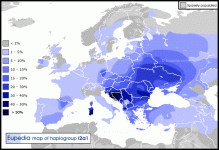Parhypostasis
Junior Member
- Messages
- 4
- Reaction score
- 2
- Points
- 0
- Ethnic group
- Predominantly a mix of Ukrainian & Polish; 1 4th Romanian, a little bit of Jewish
- Y-DNA haplogroup
- I-Y3118
- mtDNA haplogroup
- R0
23andme gives me I-Y3118 as the paternal haplogroup.
For context: My parents were born and raised in Northwestern Moldova. My DNA results give me 59% Eastern European (overwhelmingly Masovia and some of southeastern Poland, alongside western Ukraine in general, with Zakarpattia, Lviv and such), 27% Southern European (overwhelmingly Transylvanian Romanian) and 12% Ashkenazi Jewish.
As far as I understand, the I2 haplogroup is associated with indigenous european populations (Cro-magnon), but it can differ a fair lot amongst itself (I2a2 and I2a1, for example). So, I wonder: what kind of implications does it have about my origins, and what sort of general interesting information is there about my haplogroup?
[h=4][/h][h=4][/h]
For context: My parents were born and raised in Northwestern Moldova. My DNA results give me 59% Eastern European (overwhelmingly Masovia and some of southeastern Poland, alongside western Ukraine in general, with Zakarpattia, Lviv and such), 27% Southern European (overwhelmingly Transylvanian Romanian) and 12% Ashkenazi Jewish.
As far as I understand, the I2 haplogroup is associated with indigenous european populations (Cro-magnon), but it can differ a fair lot amongst itself (I2a2 and I2a1, for example). So, I wonder: what kind of implications does it have about my origins, and what sort of general interesting information is there about my haplogroup?
[h=4][/h][h=4][/h]


